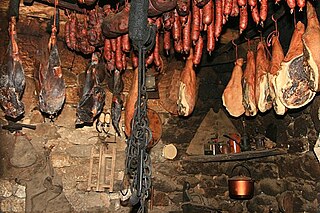 Spanish lomo | |
| Main ingredients | Pork |
|---|---|
Cured pork tenderloin is found in various cuisines in Mediterranean Europe and South America. It is typically salted or brined then dry-cured or smoked.
 Spanish lomo | |
| Main ingredients | Pork |
|---|---|
Cured pork tenderloin is found in various cuisines in Mediterranean Europe and South America. It is typically salted or brined then dry-cured or smoked.

In Spanish cuisine, lomo embuchado is a dry-cured meat made from pork tenderloin, sometimes called caña de lomo or just lomo. It is similar to cecina , but with pork instead of beef.
In Italian cuisine, there are many variants of lonza stagionata. Capocollo is very similar, but made from the neck muscle rather than the tenderloin, and often stuffed into a casing. In the northeastern border region of Trieste and surroundings as well as coastal Slovenia and Istria in Croatia (influenced by Venetian culture) it is also known as ombolo.
In Corsican cuisine, lonzu is cured loin.

In Cypriot cuisine, lountza (Greek : λούντζα) is made of pork tenderloin, which is first brined and marinated in red wine, then dried and smoked. [1]
It may be sold immediately after smoking, or aged. As it ages, it becomes harder and more strongly flavored. It may be spiced with coriander. [1]
Lountza may be served cooked or uncooked with alcoholic drinks such as zivania or wine. Grilled lountza served with other Cypriot foods such as halloumi and kefalotyri cheese often appears in meze platters. Sandwiches made out of grilled lountza and halloumi are favorite fast food snacks in Cyprus.
In the northern Cyclades islands of Greece (Mykonos, Syros, Andros, Tinos), louza is preserved pork loin. [2]
In Bosnia and Herzegovina, Croatia, Montenegro and Serbia smoked, cured loins, tenderloins and shoulder blade are called pečenica (literally "that which is baked") or vješalica (literally "that which is hung"). They are commonly made of pork but beef varieties are also not uncommon. The terms (respectively) refer to the process of smoking over heat and being hung on hooks above the source of the smoke while they're left to cure. The cuts are universally prepared only during the winter and are considered winter food. The latter of two terms is more commonly used for the shoulder blade cut, whereas the tenderloin cut is sometimes also called slatka (sweet) pečenica.
Unlike Mediterranean-style cured meats like prosciutto, pancetta and buđola (capocolla) traditionally made in dryer, littoral and near-littoral southern parts of these countries, smoke-cured loins are traditionally cured meats from the inner continental regions and harsh, freezing continental winters are a big part of curing specifics and flavor.
The cuts are first brined in solution of salt and garlic (locally salamura), to enhance flavor and help preservation, commonly together with continental-style bacon (slanina locally), lardon (also called slanina, sometimes white bacon or soap bacon) and ribs. Then they are cured by hanging them in freezing winter winds, over a smoldering lumber (smoke being essential part of the flavor) for typically up to two months, because the freezing continental temperatures and lack of insects in the winter help curing and preservation. The smolder is occasionally extinguished completely to expose the meat fully to the freezing wind.
The flavor is, as a consequence, much more intensely smoked and garlic tinged than is the case with Mediterranean-style cured meat and the cuts are typically dryer and harder. They are typically served as cold cuts, as part of traditional meze, but are also used as flavoring for various cooked dishes.
In Bulgaria, the cured pork loin is known as "Filet Elena" (Филе Елена).
All of the names above come directly or indirectly from Latin lumbus 'loin', apart from the Slavic terms from Balkans region which are derived from the actual method of preparation.

Ham is pork from a leg cut that has been preserved by wet or dry curing, with or without smoking. As a processed meat, the term "ham" includes both whole cuts of meat and ones that have been mechanically formed.

Smoking is the process of flavoring, browning, cooking, or preserving food by exposing it to smoke from burning or smoldering material, most often wood. Meat, fish, and lapsang souchong tea are often smoked.

Bacon is a type of salt-cured pork made from various cuts, typically the belly or less fatty parts of the back. It is eaten as a side dish, used as a central ingredient, or as a flavouring or accent.

Chorizo is a type of pork sausage originating from the Iberian Peninsula. It is made in many national and regional varieties in several countries on different continents. Some of these varieties are quite different from each other, occasionally leading to confusion or disagreements over the names and identities of the products in question.

Meze is a selection of small dishes served as appetizers in Albanian, Armenian, Kurdish, Levantine, Turkish, Greek, Iraqi, Egyptian, Balkan, Caucasian and Persian cuisine, to name a few. It is similar to Spanish tapas and Italian antipasti. A mezze may be served as a part of a multi-course meal or form a meal in itself. In non-Islamic countries, or in areas without alcohol restrictions, mezze are often served with spirits such as arak or grappa.

Beef aging or ageing is a process of preparing beef for consumption by aging it, in order to break down the connective tissue within the meat.

Smoked meat is the result of a method of preparing red meat, white meat, and seafood which originated in the Paleolithic Era. Smoking adds flavor, improves the appearance of meat through the Maillard reaction, and when combined with curing it preserves the meat. When meat is cured then cold-smoked, the smoke adds phenols and other chemicals that have an antimicrobial effect on the meat. Hot smoking has less impact on preservation and is primarily used for taste and to slow-cook the meat. Interest in barbecue and smoking is on the rise worldwide.
Serbian cuisine is a Balkan cuisine that consists of the culinary methods and traditions of Serbia. Its roots lie in Serbian history, including centuries of cultural contact and influence with the Greeks and the Byzantine Empire, the Ottomans, and Serbia's Balkan neighbours, especially during the existence of Yugoslavia. Historically, Serbian food develops from pastoral customs that involved the keeping of sheep in mountain highlands, in a climate and regional context that favoured animal husbandry over vegetable farming; Serbian food is therefore traditionally richer in animal products and basic grains—corn, wheat and oats—than fresh vegetable dishes. Following the abandonment of widely practiced pastoral lifestyles, Serbian food emerged through the Middle Ages heavily dependent not on lamb or mutton, but on the keeping of pigs for the annual cull and the production of various cured meats, such as sausages, bacon and ham products.

Cypriot cuisine is the cuisine of the island of Cyprus, shared by both Greek Cypriots and Turkish Cypriots.

Dried meat is a feature of many cuisines around the world. Examples include:

Salo or slanina is an Eastern European food consisting of cured slabs of pork subcutaneous fat with or without skin and with or without layers of meat. It is commonly eaten and known under different names across Eastern and Southeastern Europe, and is traditional to multiple national cuisines in the region. It is usually dry salt or brine cured. The East Slavic, Hungarian and Romanian variety is sometimes treated with paprika or other seasonings, while the South and West Slavic version is often smoked.

Pork loin is a cut of meat from a pig, created from the tissue along the dorsal side of the rib cage.

The cuts of pork are the different parts of the pig which are consumed as food by humans. The terminology and extent of each cut varies from country to country. There are between four and six primal cuts, which are the large parts in which the pig is first cut: the shoulder, loin, belly and leg. These are often sold wholesale, as are other parts of the pig with less meat, such as the head, feet and tail. Retail cuts are the specific cuts which are used to obtain different kinds of meat, such as tenderloin and ham. There are at least 25 Iberian pork cuts, including jamón.

Salt pork is salt-cured pork. It is usually prepared from pork belly, or, more rarely, fatback. Salt pork typically resembles uncut side bacon, but is fattier, being made from the lowest part of the belly, and saltier, as the cure is stronger and performed for longer, and never smoked. The fat on the meat is necessary for the curing process as it allows the salt to soak in and preserve the meat. Salt pork is made by layering salt and thin layers of meat, then dousing it in a brine mixture once the desired size has been reached.

Peameal bacon is a wet-cured, unsmoked back bacon made from trimmed lean boneless pork loin rolled in cornmeal. It is found mainly in Ontario. Toronto pork packer William Davies, who came to Canada from England in 1854, is credited with its development.

Speck can refer to a number of European cured pork products, typically salted and air-cured and often lightly smoked but not cooked. In Germany, speck is pickled pork fat with or without some meat in it. Throughout much of the rest of Europe and parts of the English-speaking culinary world, speck often refers to South Tyrolean speck, a type of smoked ham. The term "speck" became part of popular parlance only in the eighteenth century and replaced the older term "bachen", a cognate of "bacon".